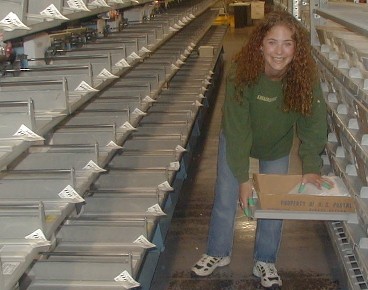
Meatpacking employees
Dan
MacLeod has been instrumental in making fundamental changes in large
organizations, including:
- Meatpacking industry
- Automobile industry
- U.S. Postal Service
He can conduct
expert needs assessments, develop training materials and programs, plan
conferences, identify potential improvements, and institute organizational
processes to affect large scale change. He calls this process
"organizational judo," using the strengths of your organization to solve
your problems.
The following provides
more details.
Changing an
Industry: Meatpacking
The
meatpacking industry has traditionally experienced the highest rates of
musculoskeletal disorders MSDs of all major industries. The impact of the
ergonomics process on this industry has been dramatic, in part due to Dan
MacLeod’s involvement. Many innovations within the industry in recent
years are the direct result of the ergonomics effort: improved safety,
reduced turnover, higher yields, and greater productivity. You can find
more information in the article meatpacking successes.
American Meat Institute (AMI)
Dan
MacLeod was retained by the AMI — the industry’s trade association in
Washington D.C. — over a period of years to assist in developing a
comprehensive program to aid its members:
- Established and
supported an industry-wide ergonomics committee
- Developed customized
training booklets and videotapes
- Planned and presented
multiple regional and national conferences and seminars
- Established and conducted
research projects on ergonomic issues
- Worked with equipment
suppliers to provide improved machines and equipment
- Developed internal
industry standards on ergonomics
- Testified before
Congressional hearing regarding meatpacking improvements
OSHA’s Meatpacking Ergonomics Guidelines
Dan represented the AMI in working with
OSHA to develop these landmark guidelines.
Individual Meat Companies
Dan has worked at one point or another with
virtually all the major meat companies. However, the individual company
where he devoted most of his activities was the Excel Corporation, based
in
Wichita, KS, with
approximately 12,000 employees in 11 facilities nation-wide.
- Implemented a joint union-management agreement to establish ergonomics
programs in all facilities
- Established and trained ergonomics committees at all sites
- Developed customized training materials and programs for managers and
engineers
- Helped plan and deliver corporate ergonomics conferences
- Developed a medical management process in conjunction with the corporate
medical consultant
- Developed innovative program tools such as audits, job evaluation
systems, and a method of documenting improvements that promoted
cross-fertilization of ideas between the different plants.
- Worked with plants to develop new equipment.
Changing an
Industry: Auto Industry
Dan
took advantage of a unique position as an in-house consultant to the
United Auto Workers Union (UAW) from 1973 to 1983 to implement many
innovative systems with the union and the industry, including the
introduction of workplace ergonomics to the industry. He markedly
contributed to using health and safety activities as a model for
transforming labor relations, helping change an adversarial system to one
of joint problem solving.
The
UAW during that era consisted of about 1.6 million members in over 3000
separate workplaces. Dan was able to draw on his organizational skills
and the strength of the union to promote many activities, including basic
concepts ergonomics and the prevention of MSDs. In this capacity, he:
- Served on the national joint safety committees between the UAW and
General Motors, General Motors of Canada, Ford, International Harvester,
and J.I. Case
- Negotiated contract language with major corporations – by 1980 he had
negotiated joint union-management health and safety agreements that
covered more employees than any individual previously, and probably
since.
- Conducted plant evaluations throughout the U.S. and Canada.
- Developed training materials and communication bulletins.
- Planned and delivered national and industry-wide conferences.
- Provided testimony during Congressional hearings for labeling of
hazardous chemicals.
- Provided testimony for OSHA hearings regarding its noise standard and
contributed to the development of the OSHA lead standard.
- Gave presentations at International Metalworkers Federation conferences
in Oslo, Norway, and Bonn, Germany.
Changing a
Large Organization: U.S. Postal Service
Dan developed and
initiated the workplace ergonomics process for the USPS and its 800,000
employees. The initial actions focused on the 350 large USPS Processing
and Distribution Centers (P&DCs) across the U.S., and subsequently
expanded to letter carriers and customer service centers (i.e., your local
post office) as part of a joint OSHA, labor union, and USPS partnership.
See
OSHA Press Release.

Postal mail sorter
Dan’s
expert capabilities in organizational change came into play in this
complex operation with a history that predates the Revolutionary War and
thus has had ample time for old habits to become engrained. His special
experience in joint labor-management programs also proved valuable.
Pilot Project
Dan started an initial pilot project at one
of the large P&DCs. Steps included:
- Conducted a background needs assessment for the pilot plant, its
ergonomics issues, and organizational structure.
- Developed customized training materials
- Established and trained a joint union-management ergonomics committee
- Worked with the committee to identify and implement low cost
improvements
- Established a system to document and communicate results
Roll Out
Dan developed and
implemented the roll out process involving 12 other professional
ergonomists, undoubtedly the largest single ergonomics consulting project
in the U.S.
to date.
- Assisted USPS staff in developing a roll-out plan
- Wrote a manual with background materials and explanation of the process
for the additional ergonomists and other plants
- Developed and presented a two-day briefing session for the additional
ergonomists to acquaint them with USPS issues
- Personally introduced the process to the initial of the large inner-city
sites (Philadelphia)
Results
The
results of the process have been well documented:
- 38%
reduction in the MSD Recordable rate
- 40%
reduction in Handling & Lifting rate
- $1.8 million savings in workers’ compensation medical costs (a 39%
reduction)
- More than 77,000 employees have been trained
- Nearly 7,000 ergonomic task analyses have been conducted and 3,600 fixes
have been implemented
Other
benefits of the process include:
- Improved mail flow
- Supervisors and employees working together to resolve problems
- Management and union leadership working together
- Better morale and evidence that the Postal Service cares about its
employees
- USPS, Labor and OSHA resolving issues as partners for better employee
health
- Better trained workforce and development of individual responsibility
for job improvements
- Improved communication and organizational skills of the ergonomics
committee members
